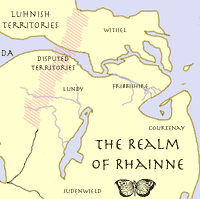Cultural and Historical Overview
The country of Rhainne comprises about one quarter of the continent of Uombiana. It runs from the colder regions of Witsiel on the Claw of Cadus to the Sudenwield in the equatorial south. Rhainne is unquestionably the wealthiest and the most influential country in the known world. Its merchant marine and powerful navy have spread Rhainnish comestibles, Rhainnish magic, Rhainnish medicine, and Rhainnish religion to the four corners of the globe. Some sages speculate that the worship of Uo, the primary Rhainnish deity, is practiced even in some orc tribes of eastern Ayyzblach. Wealthy people travel great distances to see the gambling parlors and beaches of Llleea Lake, and the Duchy of Fribbishire – with its three university cities, in addition to the trading centers of Bae Cul and Bae Durvin – is thought to be the center of the civilized world.
Rhainne is an old and revered realm, a matriarchy ruled by the daughters of the House of Deirr – mostly dragon and faerie folk. The monarchy has existed since the Treaty of 301, when the four major duchies agreed to swear fealty to Queen Erizraiche the First. Since that time, more than twelve hundred years ago, Rhainne has had a remarkably peaceful and prosperous history. Yes, there have been armed conflicts, even wars, and fierce ocean storms have battered the coasts. But there has never been a famine, and the “wars” have been more like skirmishes. During the brief reign of the revered Queen Sarichae VIII, the realm has seen three short conflicts with its western neighbor, Luhn. The current disruption has lasted for two years, resulting in the 10th blockade of the Sea of Leda. However, for most Rhainnites the war is not a dire concern, since it’s contained in a wild and sparsely settled region of the country. The great majority of Rhainnites have enjoyed a long and seemingly unending peace. Rhainnish diplomats have even succeeded in bringing peace to other realms, such as Fialle and Baazdeen, which were bitter enemies until only 25 years ago, when the Queen witnessed the heralded signature of the Treaty of Bae Cul.
Rhainne is known first and foremost as a center of gastronomy. While the great culinary institutes in the major Rhainnish metropolises train the most respected chefs in the world, it is widely acknowledged that the true source of their reputations comes from the countryside, where humble innkeepers prepare ingenious variations on hundred-year-old recipes. The great chefs of Rhainne are known to make pilgrimages to the provinces to taste such dishes, only to bring them back to the cities and claim them as their own. Thousands of spices, cheeses, wines, spirits, smoked meats, salt fishes, and alchemically derived flavors are grown and processed exclusively in Rhainne for export. Rhainnish peoples are incredibly proud of their culinary heritage, and here it is often said among the upper classes that by the time a poor child of native upbringing can feed itself, it has more taste and understanding of cuisine than the purported gourmands of other countries.
Fierce pride also characterizes another area of Rhainnish renown – alchemy. Rhainnish alchemists are credited with discovering no fewer than 40 unique pure substances, including glibdash, follybrac, limntoun, and prueditch. Many Rhainnish mages spend a large part of their advanced education researching alchemy, and in the pursuit of alchemical research they often engage in interplanar travel. Travel across the planes is essential to the discovery of new substances and new applications for known elements.
Rhainne’s merchant marine and navy, both the pride of the world, insure that Rhainnites are also well traveled on the prime material plane. Strategic deployment of the navy has enabled Rhainne to starve Luhn into submission in the vast majority of their numerous armed conflicts, since the Sea of Leda, when its ports are fed from the Idombian Ocean, is a great center of trade. During the blockade, merchants are forced into the ice-pocked northern seas, a much more dangerous and expensive route to Luhn. When the blockade is up, the fortunes of the Luhnites plummet, generally producing popular outcry against the war.
It is said that the Rhainnish demeanor is sweet, wandering, and light-hearted – even sensualist. And indeed, compared to neighboring states, Rhainnish laws and mores are permissive. The Rhainne of song and story is a place of romance and sexual liberty, especially in the southern climes, where the people partake of complex and chaotic dances involving hundreds of people at a time. Rhainnish bards are highly revered for their vigorous compositions for these ecstatic affairs, as well as for their tragic verse, and for their devotional and love poetry, inspired by Uo.
However, those who would characterize Rhainne negatively would say that it is a place of irresponsibility and immorality, of hedonism in the extreme. Stories of indifferent public officials ignoring cannibalism and random violence in certain sectors of the countryside will at times confirm the critics’ views. The festival of Soujjis, unrecognized in Fribbishire but considered by the southern peoples to be the holiest of the year, features a solid month of release from workaday obligations and, in some provinces, a suspension of all laws. Stories of horrible crimes committed during Soujjis are a source of shame to northern Rhainnites, and every year there is some attempt to outlaw the festival countrywide. Yet the tradition persists, and each year more foreigners come to participate. Wry southerners will point out that even the squeamish moralists don’t mind the tourist dollars the festival brings into the country every year.
The Luhnish Wars
To the west of Rhainne is the Kingdom of Luhn, from which a number of the country’s fiercest critics hail. Luhn shares a great deal in common with Rhainne. More than seventy percent of Luhnites worship Uo, thanks to Rhainnish missionaries from the 11th century. Luhn also is a center of dance and song, and Luhn has its own cuisine, in which it takes great pride.
Of course, differences are magnified by proximity and economic disparity. Luhnish peoples tend to envy the wealth of Rhainne – a country whose vast trading empire and natural resources have given the average citizen a far higher quality of life. Also, Luhnish problems are as numerous as Rhainnish blessings. The majority of Luhn’s resources are poured into the construction of new temples to Uo and into a powerful royal army. These forces are always having to put down one armed revolt or another. This drains the treasury and increases the incentive to blame every problem on foreign meddling. It’s not a hard sell, since Luhnites tend to think of Rhainnites as condescending, entitled, and self-important. Indeed, these sentiments are not completely unfounded.
And so, Luhn and Rhainne have been in and out of war for over a hundred years. These disputes have been ostensibly territorial; the Luhnites and the Rhainnites both claim parts of the Myn Forest, a source of Luhnish lumber and Rhainnish spices and spell components. Lately, there has been an openly religious angle as well, with Luhn claiming exclusive ownership of ancient temples in the Myn forest that had been shared by people of both countries.
Most of the wars between Luhn and Rhainne have ended in stalemate or Luhnish acquiescence, but Luhn has proven increasingly successful at making allies with Rhainne’s southern neighbors and internal enemies. Of late, Baazdeen has declared open war, bringing their small but effective navy into the conflict. Rhainne is a notoriously contentious country, filled with factions, sub-nationalities, cults, and powerful brigand groups. Though civil strife is relatively rare, corruption and assassination are not, and Luhn has made significant inroads in organizing diverse groups to work together to plot against the Queen.
Trade and Tourism
Rhainnish trade is diverse, but the bulk of its exports take the form of magical devices, processed alchemical substances, and foodstuffs. Seventy to eighty percent of these exports leave the ports of Fribbishire, with the remainder coming mostly from Courtenay. Rhainne’s most significant trading partners are Fialle, Baazdeen, Laulond, and in the absence of war, Luhn. During armed conflicts, significant trade with Luhn persists via black markets and smugglers, but this represents only about a third of peacetime activity. Rhainnish vessels also make their way to the tribal regions of Ayyzblach and Pagheran, but these societies tend to be interested mostly by weapons and spirits of questionable quality – items they can usually get more cheaply from non-Rhainnish traders.
Rhainnish tourism is driven by a number of different cultural and geographical assets. The duchies have found a variety of ways to increase the appeal of an already beautiful country. The southern cities of Llleea Lake are almost entirely devoted to tourism, and the Duke of the Sudenwield has built his wealth on the desire of people to escape the relative legal and moral strictures of the non-Rhainnish kingdoms. On the Llleea, visitors frequent elaborate brothels and engage in orgiastic dancing at religious festivals. When the festivals are over, races, sporting events, and gladiatorial entertainments take up the attention of the populace. Thousands of humanoid slaves die monthly in the arenas of Paddham and Marelle, while gamblers gain or lose fortunes on their deaths.
By no means does the Sudenwield have a monopoly on the attention of travelers, however. Northern attractions bring as many people into the country as these more illicit entertainments. The cultural wealth of the northern cities draws great numbers of pleasure-seekers. And Lundy’s religious shrines bring pilgrims from all over the world, come to give offerings and do service in the name of Uo.
Race and the Races
Perhaps surprisingly, regional, tribal, and class differences are of far greater significance to the average Rhainnite than racial ones. A rich Speezidvian elf mage might look askance at a Myn wood elf entering an exclusive tavern. But the same mage would think nothing of sharing a glass of wine with a wealthy dwarvish friend. The races of Rhainne are highly diverse but also highly intermingled. Gnomes, halflings, elves, dwarves, and a not insignificant population of goblins, hobgoblins, and orcs all go about their business without giving race much of a thought. Tribal seclusion will sometimes keep one race dominant and isolated in a small rural region, but in the large cities and much of the countryside, the races freely interbreed and socialize. One exception to this rule is in Fribbishire, where a large population of fey creatures looks upon other humanoids with the mildest condescension. A dryad who mates with a human might endure some ribbing from her friends, but no worse censure than this. In fact, it is not uncommon for races that are traditionally unable to mate (dragons and humans, for example) to be genetically combined by magical means. Racially unique children are viewed as highly desirable, and many believe that Uo blesses them with interesting destinies.
The DUCHY OF FRIBBISHIRE
The Northeast/ High Lakelands
Northeastern Fribbishire comprises a large peninsular region bordered on the east by Ruskaen Bay and the Idombian Ocean, on the West by the Myn Forest, on the north by the Bay of Luza River, and on the south by the Duchy of Courtenay. The coastline of this peninsula is covered with cliffs and craggy mountains, the geology of which is quite dramatic. Vast tracts of limestone and sMartin are interlaced with rich veins of onyx, opal, and jade. Rock formations of extraordinary height, canyons and cave complexes plunging deep into the earth, sometimes even under the ocean, covering untold miles – these provide shelter for the largest community of dragons in the known world, as well as a variety of unusual subterranean species. This region on the coast of northern Fribbishire is known as Goin, and it is home to a variety of towers, shrines, and retreats. Among these famous structures is the Great Shrine of Uo, the center of worship for the primary God of the Rhainnish pantheon; Lyshi Palace, the favored home of the Queen of Rhainne; and the unreachable Tower of Diepe, rumored location of Uo’s harem of 100 mortal concubines. The wealthiest and most powerful citizens in all of Rhainne are known to make their homes here.
Further inland, the rocky, sandy terrain gives way to verdant rolling plains, interspersed with small forests and the occasional bog. This is the main portion of what is known as the High Lakelands, and it is home to a number of important Rhainnish cities, including Speezidvia, Finziandia, and Bronzoni. The High Lakeland cities host the greatest magical gymnasia in the entire world, where the great inquiry into the nature of the planes is carried out by thousands of Rhainnish sages. Some would say the High Lakelands are the center of Rhainnish, if not world, culture, and indeed it is here that many of the world’s greatest dancers, musicians, chefs, mages, sages, craftsmen, and artists make their homes.
The Low Lakelands
As one travels south from the High Lakelands, the number of farms diminishes slightly as the forests begin to grow ever thicker, the canopies of the trees ever taller. Soon one comes upon the Sweet River, a body so named because its waters are said to taste mildly of honey and also for the wealth of the communities which surround it like a spike of gold running right through the heart of the duchy. At the mouth of the sweet river is the Capital of Rhainne, Bae Cul – which means “Heart of the Valley” or “Luscious Berry”. Bae Cul is the largest trading port in Rhainne, home to the palace of the Duke of Fribbishire and to the Hall of Ease, where the Council of Lagans assembles. It is also the homeport of the formidable Rhainnish Navy.
Further east from Bae Cul, a network of canals connects the Sweet River and the Ouy River, between them a thick web of wealthy bedroom communities and large farming estates. Like an intricate road system, these canals are busy and frequented by traders, travelers, tourists, and thieves. Most of the communities between the rivers are terribly wealthy – some, for example, are constructed entirely of marble and gold. Servants are paid well and have tremendous freedom (it is often difficult to distinguish master and servant by the usual indicators, and some servants will pose as their masters). Though servants live with their masters’ families, changing masters is very common, and some highly skilled servants wield considerable power in the service of a lord.
South along the Ouy River is the large trading city of Bae Durvin. Bae Durvin is not quite as big a port as Bae Cul, but it is sizeable, and it is a main distribution point for goods bound south.
Farther east is the region called Tetsk and the Still Swamp, where the Sweet River empties into Ruskaen Bay. It is known that a tribe of barbarian lizard men inhabit this swamp, an isolated area that is left alone – barring a few mage’s servants and others looking to harvest valuable spell components, minerals, molds, spores, plants, and fungi.
West of the Ouy River is the Weslow or the Western Low Lakelands. In contrast with the hilly, forested region between the rivers, the Weslow is mostly grassland pocked with lakes and scrubby forests. Small farms and a few large estates populate the area, where they raise livestock, corn, wheat, barley, and soybean.
Middle West Fribbishire
The western frontiers of Fribbishire are primarily grassland, though the beginnings of the Myn Forest (a dense wood where many strange beasts dwell) are in the north. The Myn is home to many Rhainnish wood elves, and it is higher and hillier than the plains that surround it. Middle West Fribbishire is far less densely populated and cosmopolitan than the rest of the Duchy, and the residents of the Middle West are alternately proud and resentful of their wealthy and cultured neighbors. Their lifestyles more closely match the people of the Duchy of Courtenay to the south, the bulk of which make a living as woodsmen or subsistence farmers.
Matters of Spirit
It would be a great understatement, even a misrepresentation, to say that the people of Rhainne are highly religious. This is because the spiritual world is present to the average Rhainnite in ways that it is not and cannot be in the “real” world. Imps, demons, sprites, fairies, ghosts, demigods and other ethereal creatures take an active role in the daily lives of Rhainnish people. It is not possible to be an atheist in Rhainne, since the empirical evidence of the existence of the spiritual realm makes such a belief system unreasonable. For example, no Rhainnite would be skeptical if you told them that a ghost lived in your house – but if you said that Uo sent the ghost to punish you for failing to attend church services, it might inspire debate. In Rhainne, faith is more a matter of “why” than “what”.
Uo, the great mistress of pleasure, is the central God of the Rhainnish pantheon. All worshippers of Uo believe that existence emerges from Uo’s stream of unending joy, usually considered symbolically to be a peal of joyous laughter. Fire, water, earth, and air all derive from this basic energy and are representative of different kinds of pleasure. Earth is symbolic of satisfaction that is enduring and productive; air is satisfaction that is delicate and fleeting; water is pleasure that is cyclical and renewing; fire is pleasure that is intense, purgative, and consuming. The gift of pleasure is the chief blessing of Uo, and all Uombians see the taking of pleasure as holy. The corruption of the stream of pleasure is the greatest evil, and it occurs when people forget to make pleasure the highest concern of their lives. This happens, for example, when people seek power as an alternative to pleasure. It is axiomatic for Uombians that the purest pleasure is in mutuality. When pleasure is taken at the expense of others, it is as much an exercise of power, and so it corrupts the stream of pleasure. These are the basic beliefs of the devotees of Uo.
However, here the similarities between worshippers of Uo come to an end. The debate over what, exactly, constitutes the taking of pleasure and what constitutes the corruption of the stream of pleasure is unending. For example, many Uombians view sexual congress as the greatest blessing Uo offers mortals. It is seen as the quintessential opportunity for taking pleasure. Others see sexual congress as primarily representative of only one particular kind of pleasure, a fiery one. These Uombians say that Uo’s followers should seek holiness in the balance between the four elemental kinds of pleasure.
These two views represent the most basic division between followers of Uo, and generally these are called the Khida and the Arvida schools. The Khida tend to worship fire and air sub-deities; they tend to be what we call “hedonists”, seeking holiness in sex, food, and diverse experiences. The Arvida tend to worship all the sub-deities simultaneously, with an emphasis on earth and water. Arvidic teachings emphasize the pleasures of family life, community, friendship, and education.
The Khidic/Arvidic divide is hardly the only schism in the vast worldwide congregation of Uombians. In fact, two Uombians from different regions are likely to be as different in their belief systems as two worshippers of completely different deities. One reason for this is that Uombianism is both monotheistic and pantheistic. Uo is said to have spawned thousands of children and grandchildren, and most Uombians believe that one of these children is her favorite. These sub-deities serve as messengers taking the concerns of worshippers to the great mistress. Sometimes the child takes on as much importance for a devotee as Uo herself.
Technomagica
Rhainnish technological advancement is a mix of the medieval and the pre-industrial. Significantly, gunpowder, electricity, and fossil fuels are only vaguely understood. (And yet, magical means provide many things that industrialization would not.) Most civilized people do not burn coal, and oils are not refined for systemic use as a fuel or light source. There are oil lamps in homes, but nothing like the gaslight systems of the19th and 20th centuries. There are also no steam engines for powering ships, looms, presses, or production lines. Most things that people use daily – from clothing to furniture to ships – are made by hand. Some sages understand gunpowder and its capabilities for rapid combustion, but the application of the substance is more advanced in public entertainments than in engines of war. There are no ball-and-powder firearms. However, there are extremely powerful magical weapons. Rhainnish naval ships, for example, carry enchanted cannon of extraordinary power.
So, in many ways, Rhainne calls to mind the medieval period of western history. In rural areas, crude stone or clay structures with thatch roofs are common. Primitive, locally maintained roads connect most dwellings and population centers. The people make ninety percent of their worldly possessions themselves; the rest they trade for in the nearest town. Most farm work is accomplished by use of beasts of burden, and government is a strictly feudal arrangement in which large landowners swear vassalage to one of the four ducal houses. The lower classes have some rights – but most of these are forfeit once they sell themselves into lifelong service to a landowner (the most common scenario).
Thanks to a combination of magic and science, things begin to look a bit more like 18th and 19th century Europe in more densely populated areas. Cobblestone streets are lit with enchanted lamps. Houses are made of planed wood or brick with glass windows and have up to four stories. Expert masons and sculptors, capable of cutting marble, sandstone, and slate with precision and artistry, construct impressive public buildings. Primitive sewer systems run under the streets in vast networks. Clothes are more refined, made on a large scale with the aide of magico-mechanical looms and wheels. (Silk, lace, gold leaf, and taffeta are the essential components of any wealthy city-dweller’s wardrobe.) Magically powered clocks are an increasingly common accent in fashionable homes. Medicine as we know it is almost non-existent, but divine healers of tremendous power cure ills that would confound contemporary surgical practice. Finally, a primitive kind of representative government can be found in some densely populated areas -the Council of Lagands, for example, represents the Lakeland districts of Fribbishire, and its influence on the Queen is not insignificant.








